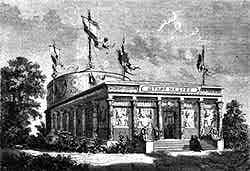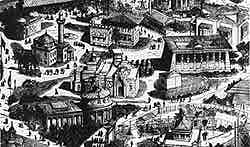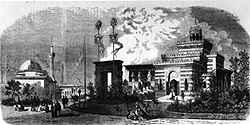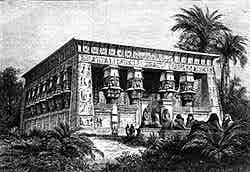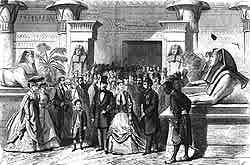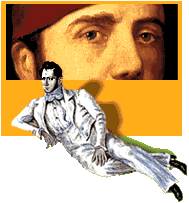 |
In 1867, Théophile Gautier wrote six accounts of the Universal Exhibition for Le Moniteur universel. The fifth article was dedicated entirely to a visit to the Suez Isthmus pavilion.
Théophile Gautier
“The Suez Isthmus”, Le Moniteur universel, no.215, Saturday, 3 August, 1867.
At the door, your eyes are immediately drawn to a square pillar
made of a semi-transparent material. It is a block of rock salt
cut from the bottom of the Bitter Lakes of the Suez Isthmus. If
it had not been for the difficulty of transporting it, it could
easily have been twice or even three times as big, as the layer
of rock salt is so thick that they used to sculpt obelisks from it.
You go in and find yourself in a huge room lit from above and
whose temperature, when the sun shines in at the windows, cannot
be far from what was warming Mr de Lesseps workmen. A maharie,
a white-haired racing camel, and very artistically stuffed, completes
the local colour. Along the walls and in the windows are arranged
examples of the small flora and fauna of the country, shells from
the two seas, some fossil remains and a few small examples of
antique art found when digging the canal. In the middle of the
room, on a wide table, there is a model of the Suez isthmus, a
strange yellow slash between the two azure seas.
Here and there, a few thin patches of green colour the sand; arid
dunes undulate along the plain on the side of the Red Sea and
cross that valley of Wilderness where the Tribes of Israel wandered
after their exodus from Egypt. The Suez Isthmus forms a kind of
dip between Africa and Asia, where the hills gradually flatten out to become almost
imperceptible slopes.
Sesostris’ idea was taken up again by Mr F. de Lesseps and achieved
using the power of modern science. This gigantic project, conceived
in 1844, is already no longer just a project. The dream is becoming
reality. Only three tasks remain: a few kilometres need to be excavated on the
El-Guisr plateau; the Serapeum has to be pierced; and the narrow band separating
the extreme south of the Bitter Lakes from the tip of the Suez
gulf must be dug. It is a job of two or three years, and then vessels
will pass from one sea to the other through the ‘Bosphorus’ made
by human hands.
A similar operation on the Panama isthmus, that thread holding
together North and South America and blocking the passage from
the Atlantic Ocean to the Pacific Ocean, will allow man to circulate
freely around his globe, eliminating useless, enormous, detours.
We must do this soon because the planet has to be organised for
the future, a future which although as yet unknown can be fairly accurately
predicted, judging from great scientific discoveries which are
the honour of our century.
There are more models on other tables representing different sections
of the canal and showing the powerful machines which now replace
the fellahs. There are dredgers, chutes (a cross between
sloping bridge and a steel roller coaster, designed for dumping the earth - torn from the bottom of the canal - as far as possible from the
banks), lighters, tugboats
and many sorts of amazingly specialised machines, all reproduced
to such a scale that none of the detail is lost and ranged along this blue
ribbon bordered by two banks of yellow sand.
To get to the panorama you climb to the upper platform which is
covered with canvass. Here you pass down a dark corridor. And
when you suddenly emerge, the viewer is immediately struck by
the sky (azure turning white from the intensity of the light).
You’re straight-away transported to steamy Africa. It is as if
beads of sweat are suddenly trickling down your temples after
you have disembarked in Port Said from one the Messageries impériales
boats. But this voyage can be completed in a much shorter time.
A canal entering a lake as if it were passing between two brick
walls is a strange thing in itself, but it is not the strangest
of the elements in this gigantic construction. It represents a
stretch of 45 kilometres - something which the panorama of course
abbreviates. In one part we see the encampment at Al Quantara
with its double rows of huts, its hospital on a rise and its swing
bridge crossed by the Syrian caravans.
The canal leaves Lake Menzaleh and heads for the dry land - but
not for long, for soon it reaches Lake Ballah, an irregular defile
which over the years has either been abandoned or filled with
water. Here the land rises up and forms a sort of barrier and
it is called the sill of El Guisr. This sill had to be cut to
allow the canal to pass through. We see the village of Ismailia,
the director’s residence, and like a silver thread heading for
fertile Egypt, there is the freshwater canal whose waters feed
a new town. On the left the scorched, sterile sands stretch in
dusty dunes towards Syria. Near to Ismailia, you can see the Arab
village with its bazaar and mosque. The fact is, that in painting
their panorama, Messrs Rubé and Chaperon have had to forget real
proportion and to give more importance to certain points of note
and to limit the amount of space given to the desert parts, which
being so similar would have merely filled up large parts of the
canvas to no good end.
This vast bowl holds the vast number of 900 million cubic metres
of water, and a whole year will be required to fill it with sea
water - this is planned for when all the construction work is
finished. One last obstacle faced de Lesseps’s men preventing
them from reaching the Red Sea - a ridge of exceptionally hard
stone, stretching several kilometres in the Chalouf region and
which had to be dynamited to create the appropriate gap. After
this there is the Suez plain at the feet of the djebel Genessé
and the last hillocks of the Attaka. The encampments of the Company
workers stretch picturesquely across the sand and next to this
the railway line, a thing line of metal, smoke streaming from
the smoke stack at the front, passing from Cairo to Suez.
The whole of this corner of the panorama is superbly coloured.
We see how the sun catches sand dunes, how the light catches a
dark cloak, how azure and amethyst shadows contrast with golden
and pink lights. Thus revealed, the ‘skin’ of the planet has the
shining of a star, such as the earth must look in the sky when
viewed from the moon.
When one leaves the rotunda, one gets the impression of having
made the journey to the isthmus, of having passed from one sea
to the other on the sort of steamboat which will soon make the
direct trip from Marseilles to Calcutta.
Théophile Gautier (1811-1872)
 |
